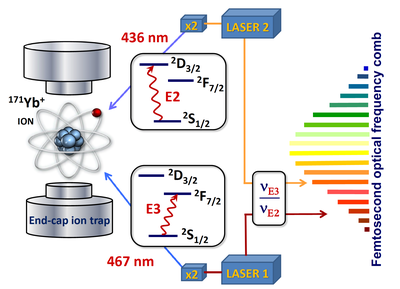Particle traps, lasers, frequency combs
High-precision clocks based on atoms, ions (more) or molecules are sensitive devices in searches for ultra-light dark matter particles. The most advanced clocks store 100 to 106 particles in suitable traps. Modern laser technology is used to cool and interrogate the particles. For the actual operation as a clock, lasers are locked to the frequency of long-lived electronic transitions (clock transitions). The laser frequency is then measured with the help of frequency combs.

The above plot (taken from this review paper) illustrates the measurement principle for the case of a single Ytterbium ion (171Yb+). The ion is kept in an ion trap and cooled to minimize effects like Doppler broadening. Two lasers at 436 nm and 467 nm are locked to two different electronic transitions (an electric quadrupol (E2) and an electric octopol (E3) transition). The two transition frequencies are measured as a function of time by a femtosecond optical frequency comb. Any time dependence of the ratio of the two frequencies could be in indication for a time dependence of fundamental constants or an interaction with dark matter.
In the case of the Ytterbium ion, the frequency comparison takes advantage of two transitions in the same ion. Conceptionally, one of the transitions could be one in a different type of clock located far away. A frequeny comparison is then still possible when the laser signal of the remote clock is transferred to the local frequency comb with the help of e.g. glass fibre cables. One such clock network is planned within the QSNET project.
